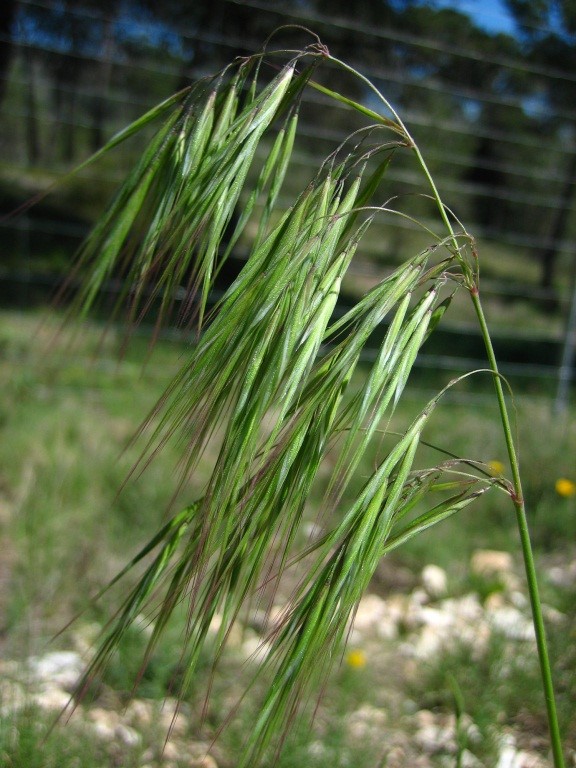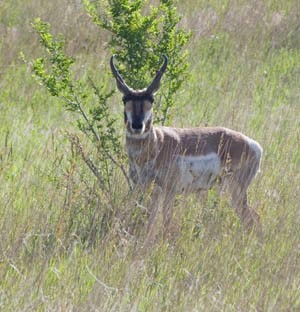Interactions
Since Bromus tectorum has invaded in several parts of the world
there are several other organism and species that it encounters or
has an effect on. Again, there are so many that I couldn’t possible
catch them all, but we will look at many interactions that go on in
this invasive species life.

Fungi
Let’s start with something smaller. Cheatgrass is known to host over
one hundred units of endophytic fungi; the grass acts as a host for the
fungi. A fungivorous nematode, Paraphelenchus acntioides,
and an endophyte, Fusarium cf. toulosum, are two other
microscopic species that are associated with B. tectorum.
It is proposed that the fungivourous P. acontioides uses
living plants, like that of Cheatgrass, to increase the amount of
the desired fungus on the plant (Baynes et al. 2012). Cheatgrass
plants might also be inhabited by
vesicular-arbuscular mycorrhizal fungi. It is also commonly
known to be infested with a head smut fungus, Ustilago
brominvora. This fungus can temporarily reduce the amount of
Cheatgrass on some sites; it does this by colonizing the seeds and
roots and then produces a toxin that apparently puts cell growth to
a halt in new growing plants (Zouhar 2003). For more
information on the fungal interactions, take a look at the
Prevention Page.
Grazing
Some other interactions that B. tectorum goes through is
the grazing by cattle, horses, and sheep (Forest and Range 2006).
Cheatgrass can tolerate repeated grazing, but it becomes an issue
when it turns to heavy grazing because it destroys its ability to
invade as efficiently via seed production. After about 8 weeks in
the digestive tract of cattle the Cheatgrass seeds can no longer
reproduce or grow (Zouhar 2003). However, there are times where
excessive grazing can help B. tectorum expand because the
cattle, or whatever else is eating it, are also eating the perennial
plants. When this happens it allows the Cheatgrass seeds to dominate
the land during its next growing season (Zouhar 2003).
Uses for other Species
Cheatgrass is not always a bad thing. It is a food source and home
for many animals. In the winter, fields of B.tectorum turn
to a bed and some “hay” for several cattle and horses. These animals
would prefer to have something else, due to the grass being an
inadequate source of protein, but they would eat that over starving
(Zouhar 2003). Cheatgrass is also a viable food source for lamb
ranges (Zouhar 2003). When dry Cheatgrass is being eaten by
livestock the animals need to be watched more closely. As the grass
matures it dries out and the seeds become sharp; this can be a
hazard to animals because it increases the occurrence of mouth
infections and eye injuries (Zouhar 2003). Several other animals use
Cheatgrass as a source of food. Some examples include: ground
squirrels, pronghorn, mule deer, bighorn sheep, montane meadow mice,
several birds, other small mammals, and insects. They all use the
invasive grass as a way to live and in the mean time they are
shaping the land of where the grass intends to grow (Zouhar 2003).
Harm
Usually with some positive news come some bad new too. So let’s see
how B. tectorum is also a harmful species in other ways
than just its invasiveness.
Some native plant and animal species that live among Cheatgrass are
at risk of going extinct (Zouhar 2003). The amount of fires that
happen due to this invasive species is eliminating important food
sources for many of the deer and elk. With only having Cheatgr ass as
the main source of vegetation, the biodiversity of all herbivores
and carnivores is being reduced due to lack of resources (Zouhar
2003). Cheatgrass is also associated with the decline of many small
mammal populations, and there are two factors that limit this. The
first is increased predation due to loss of shrub coverage and the
second is the thickness of the fields might be blocking and trapping
young mammals, leaving them for death. Loss of smaller mammals can
just have a domino effect on the food chain because the species that
were feeding on them are now losing their food source. Unless they
adapt or find another food source, larger species will start to be
effected too (Forest and Range 2006).
ass as
the main source of vegetation, the biodiversity of all herbivores
and carnivores is being reduced due to lack of resources (Zouhar
2003). Cheatgrass is also associated with the decline of many small
mammal populations, and there are two factors that limit this. The
first is increased predation due to loss of shrub coverage and the
second is the thickness of the fields might be blocking and trapping
young mammals, leaving them for death. Loss of smaller mammals can
just have a domino effect on the food chain because the species that
were feeding on them are now losing their food source. Unless they
adapt or find another food source, larger species will start to be
effected too (Forest and Range 2006).
Cheatgrass
has even become a problem in alfalfa and wheat fields in the winter.
Since it can survive and reproduce in colder temperatures they
invade the farm lands while the crops are lying dormant (Forest and
Range 2006). The biomass of these crops can be significantly
lowered. To fix this, it has been suggested that certain perennial
grasses, like bluebunch wheatgrass, bottlebrush squirreltail,
Elymus
elymoides, and a few others can be introduced to a field of
B.
tectorum and they have a chance of being a source in an ecological
restoration process (Zouhar 2003). These grasses have a competitive
impact on Cheatgrass and slow down its growth and reproduction.